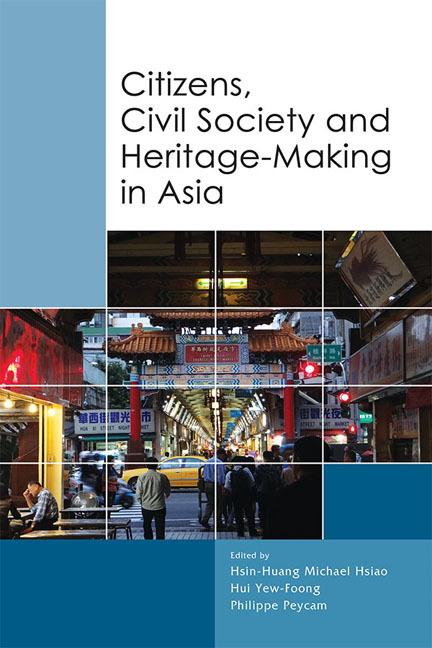Book contents
- Frontmatter
- Contents
- Contributors
- 1 Introduction: Finding the Grain of Heritage Politics
- 2 Heritage, Identity and Power
- 3 Heritage-Making and Post-coloniality in Yangon, Myanmar
- 4 Living Heritage of Ruins? Contesting the Paradox in Trowulan's Majapahit Heritage
- 5 The Reconstruction of Heritage in Rural Vietnam: An Analysis of State and Local Dynamics
- 6 Performing Cultures, Negotiating Identities: The Cultural Politics of Indigenous Cultural Villages in West Malaysia
- 7 Constituting Philippine Filmic and Linguistic Heritage: The Case of Filipino Regional Films
- 8 Encounter and Counter-Narratives of Heritage in Macau
- 9 Cultural Activities of the Chinese Community in Post-war Myanmar
- 10 Chinese Street Opera in Singapore: Heritage or a Vanishing Trade
- 11 Policy Formation and Civil Society Engagement in Heritage-Making in Taiwan: A Historical Examination
- 12 Becoming Taiwanese: Appropriation of Japanese Colonial Sites and Structures in Cultural Heritage-Making — A Case Study on the Wushantou Reservoir and Hatta Yoichi
- 13 Defining Culture in the Heritage Preservation of Taiwanese Veterans’ Villages: The Case of Zuoying
- 14 Tobacco Crop Memories in Taiwan: The Heritage of a Deadly Agriculture
- Index
4 - Living Heritage of Ruins? Contesting the Paradox in Trowulan's Majapahit Heritage
Published online by Cambridge University Press: 03 January 2018
- Frontmatter
- Contents
- Contributors
- 1 Introduction: Finding the Grain of Heritage Politics
- 2 Heritage, Identity and Power
- 3 Heritage-Making and Post-coloniality in Yangon, Myanmar
- 4 Living Heritage of Ruins? Contesting the Paradox in Trowulan's Majapahit Heritage
- 5 The Reconstruction of Heritage in Rural Vietnam: An Analysis of State and Local Dynamics
- 6 Performing Cultures, Negotiating Identities: The Cultural Politics of Indigenous Cultural Villages in West Malaysia
- 7 Constituting Philippine Filmic and Linguistic Heritage: The Case of Filipino Regional Films
- 8 Encounter and Counter-Narratives of Heritage in Macau
- 9 Cultural Activities of the Chinese Community in Post-war Myanmar
- 10 Chinese Street Opera in Singapore: Heritage or a Vanishing Trade
- 11 Policy Formation and Civil Society Engagement in Heritage-Making in Taiwan: A Historical Examination
- 12 Becoming Taiwanese: Appropriation of Japanese Colonial Sites and Structures in Cultural Heritage-Making — A Case Study on the Wushantou Reservoir and Hatta Yoichi
- 13 Defining Culture in the Heritage Preservation of Taiwanese Veterans’ Villages: The Case of Zuoying
- 14 Tobacco Crop Memories in Taiwan: The Heritage of a Deadly Agriculture
- Index
Summary
Widely recognized from school history books in Indonesia, the name Trowulan is most familiar to Indonesians as the ancient capital of the glorious Majapahit Empire. The official narrative of Indonesia's national history features the kingdom of Majapahit with the notion of archipelagic unity as one nation, “Nusantara”, through the Palapa Oath made by its first minister Gajah Mada. Recently though, historians have been increasingly questioning the appropriation of Majapahit in the nation-building narrative due to the mixture of myth and reality in the construction of Majapahit as the root of Indonesian nationalism. The reality of present-day Trowulan is that it resembles more a village than a city. According to the 2010 Census, the population of Trowulan was 68,154, which puts it far from being a “city”. It is under the regency of Mojokerto, which is about sixty kilometres from Surabaya, the second-largest city in Indonesia.
Majapahit buildings in Trowulan are now largely ruins. Except for those that have been appropriated and altered as shrines, residents of Trowulan are not using these ruins in their daily activities. Yet, they live with the ruins and often utilize them as resources, such as in producing new bricks (although the practice of using old Majapahit bricks to produce new bricks is unacceptable under official heritage preservation norms). The Ministry of Culture and Tourism of the Republic of Indonesia had proposed Trowulan as a World Heritage site, and it has been on UNESCO's tentative list since 2009.
Trowulan's Majapahit heritage has been subjected to the invention and reinvention of later societies according to their own agendas. Applying the term living heritage to Trowulan would therefore appear to be a contradiction, especially since there is no evidence that the current residents have continued through the generations the cultures of the Majapahit Empire. Yet, we argue that living heritage exists even in an ancient heritage site like Trowulan that has gone through many years of contestations and appropriations for political and cultural legitimacy. How does living heritage relate to the everyday realities of historical ruins? By bringing together the historiography and the voices of residents, scholars and heritage enthusiasts, we find that living heritage is by no means an idealistic practice.
- Type
- Chapter
- Information
- Citizens, Civil Society and Heritage-Making in Asia , pp. 61 - 85Publisher: ISEAS–Yusof Ishak InstitutePrint publication year: 2017

